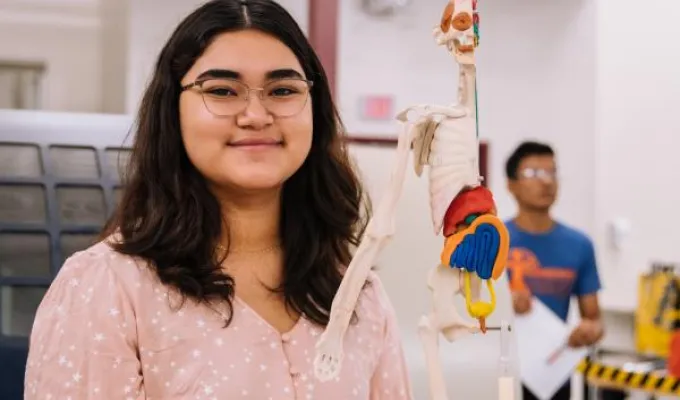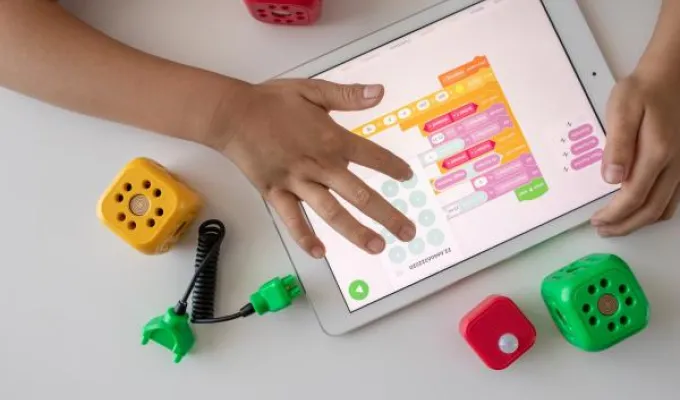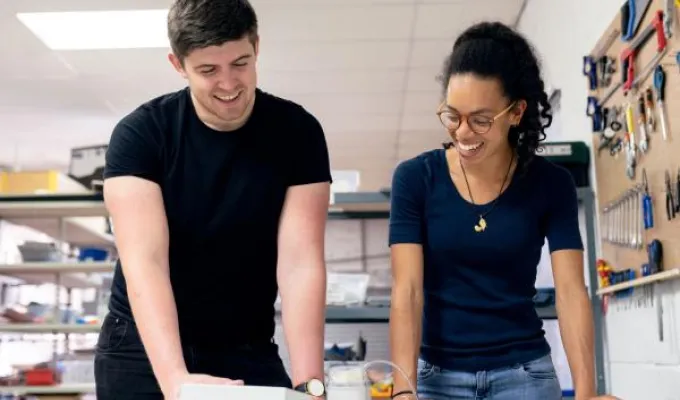STEM experiences and education provide pathways to a greater range of life choices and skills that increase an individual's ability to lead a successful life, including: problem solving, critical thinking, resiliency, the ability to fail, and analytical skills.
Minnesota Compass and Boston Scientific teamed up to provide a framework for tracking STEM growth in our state. Our new framework and measures are meant to guide STEM stakeholders in eliminating barriers and creating environments, opportunities, and engagement that allow youth and adults to see themselves in STEM, learn, and succeed.
How does Minnesota fare on key measures of STEM success?
Our new framework provides a comprehensive set of measures that track three components of STEM growth:
- Identity: The extent to which individuals see themselves and feel comfortable in STEM.
- Interest: Curiosity and engagement in STEM subjects.
- Achievement: An individual’s ability and skills in STEM subjects.
These tables show how Minnesota fares on key measures of STEM identity, interest, and achievement.
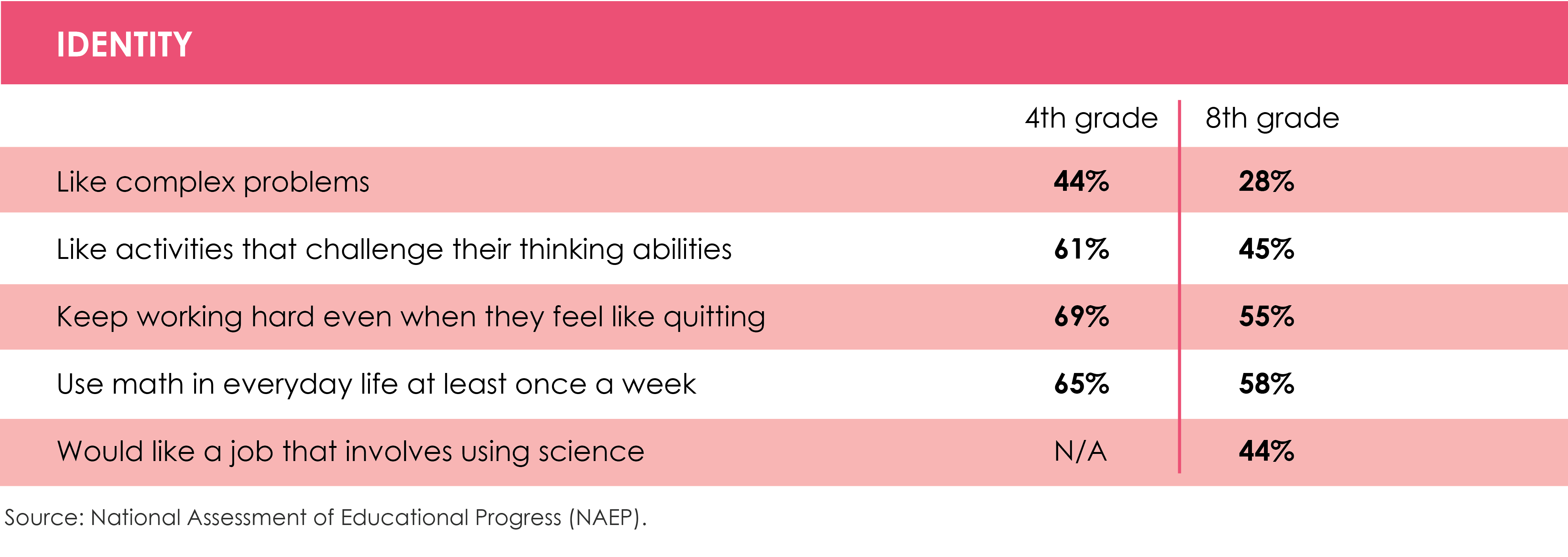

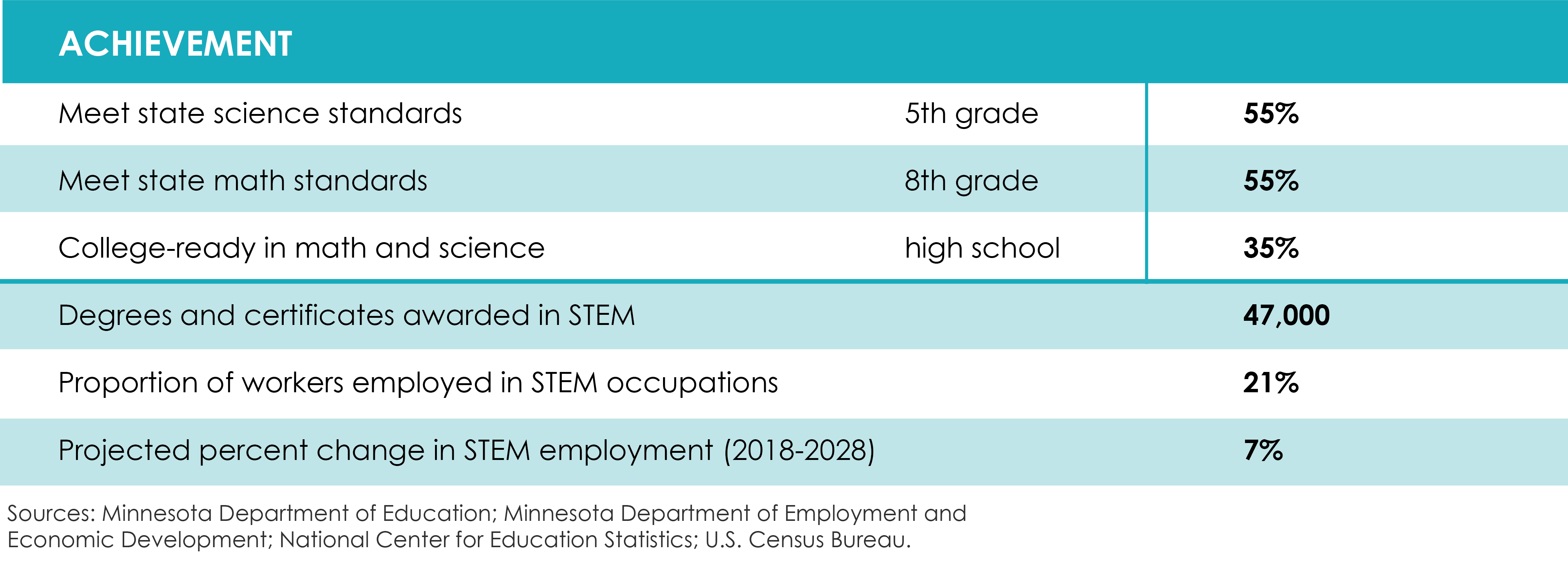
There is room for improvement across most measures
of STEM development and growth.
We can do better at cultivating and promoting STEM identity, interest, and achievement among students. Less than half of 4th and 8th graders like complex problems. Just over half of 5th graders meet or exceed state science standards. The same percentage of 8th graders meet or exceed state math standards. About a third of high school graduates show an interest in studying STEM after graduation and about a third are college-ready in math and science.
There is a notable difference in STEM identity
between students in 4th and 8th grades.
We all have a role to play in boosting and maintaining a student's commitment to development and sense of belonging in STEM. Differences between students in 4th and 8th grades range between 7 and 16 percentage points, with the largest differences on identity measures:
- Students who like complex problems
- Students who like activities that challenge their thinking abilities
- Students who keep working hard even when they feel like quitting
Are we making progress over time?
In addition to knowing where we are at, it is also important to know where we have been to understand where trends are pointing.



We have stayed the same—or become worse—on several measures
of STEM identity, interest, and achievement.
Shares of 5th graders meeting science standards and 8th graders meeting math standards have declined for the last few years. While the share of high school graduates who are college-ready in math and science has remained steady, the share who are interested in STEM has declined. These trends call for targeted and aligned strategies that promote STEM growth.
What strategies can stakeholders employ to ensure that all Minnesotans are supported in their STEM development and growth?
Our new framework equips STEM stakeholders with information that encourages them to work together to foster an equitable, vibrant, and future-ready Minnesota through STEM identity, access, interest, and achievement. We take an ecosystem approach. Children and adults interact with STEM in multiple environments, with many actors, and across a variety of sectors. All of those environments, actors, and sectors have a role to play in encouraging STEM growth.
Here's what you can do
Are you a parent? Do you work in government? Are you a teacher? An out-of-school practitioner? Our STEM access toolkit provides concrete recommendations and action steps, no matter how you identify as a STEM stakeholder. Common themes throughout the toolkit are relationships, collaboration, and alignment across sectors to work toward common goals and outcomes.
What’s next?
As always, our Compass team will update charts and key measures as soon as new data are available. We will also be releasing new content on topics related to STEM access on a regular schedule. Stay tuned for articles coming soon on STEM course availability in Minnesota’s schools, disparities in STEM growth and education, barriers to STEM participation, and STEM culture and perceptions, among others. Keep a close eye on this website or subscribe to our newsletter to stay on top of the latest!
Goal
Working together to foster an equitable, vibrant, and future-ready Minnesota through STEM identity, access, interest, and achievement.
Minnesota Compass has developed a new framework tracking STEM growth across three critical components of STEM growth:
The framework includes 15 key measures that help us understand where we stand and where we need to target our efforts and resources to achieve desired outcomes.
A goal of this project is to highlight the need to take action and shift to an ecosystem approach to STEM in education, programming, resources, and policy, as well as measurements and data gathering to track progress toward desired objectives and outcomes. An ecosystem approach shifts responsibility for STEM learning and success from individual learners to educators, organizations, funders, policymakers, and systems.
How can we help ensure that all Minnesota residents enjoy the benefits of a healthy STEM ecosystem? Explore the resources on this page to see how and where your help is needed.
Access toolkit
- Ask engaging questions.
- Provide opportunities for early engagement in STEM activities through play.
- Support STEM exposure and increase confidence with STEM tools through computer ownership or practice (e.g., in homes, at local libraries), camp attendance, and family outings.
- Develop and maintain strong relationships with teachers, other school staff, and out-of-school providers.
- When uncomfortable with STEM subjects, use high-quality education media (e.g., books, applications, videos) to support and extend school learning into the home.
- Recognize the ways that STEM learning is already present in many early childhood classrooms.
- Engage in STEM-themed play.
- Develop STEM confidence by presenting young children with "real-world" problems and asking them to develop their own solutions.
- Maintain a positive attitude about STEM subjects and activities, using inquiry-based approaches to solving problems and answering questions.
- Take opportunities to engage in STEM professional development to increase confidence in STEM education, as these opportunities are available and accessible.
- Provide students with opportunities to explore "real-world" situations and develop their own solutions.
- Encourage experimentation, including developing solutions, flexibility, risk, trying, failing, succeeding, learning, revising, reformulating, etc.
- Give students opportunities to build positive relationships with role models and mentors of diverse backgrounds.
- Integrate STEM learning into non-STEM subjects.
- Engage in ongoing professional development around leadership, student-centered learning, project-based learning, culturally relevant pedagogy, use of technology-supported learning tools, and STEM subjects.
- Support and encourage participation in a variety of out-of-school learning opportunities (e.g., summer programs, after school programs, science fairs, Olympiads, competitions).
- Set high expectations for students.
- Offer students opportunities for autonomy, ownership, self-efficacy, and choices (e.g., in how to solve a problem).
- Develop and maintain strong relationships with parents and caregivers, adults and role models in STEM.
- Recruit and retain teachers from diverse backgrounds.
- Have confidence in the role that out-of-school time has in impacting STEM identity, interest, and achievement, including problem-solving, decision-making, STEM skill-building, career awareness, and teamwork.
- Work in collaboration with other out-of-school practitioners and researchers to develop common and appropriate frameworks for describing and measuring program impact.
- Recruit and retain practitioners from diverse backgrounds. Include mentors and speakers from diverse backgrounds to ensure that students see themselves in STEM opportunities.
- In partnership with K-12 schools, offer pre-college STEM programs to encourage early exposure.
- Provide students with opportunities outside of traditional lecture-based classes to engage in active and group-based learning.
- Encourage peer tutoring and support.
- Intentionally tailor programs, practices, and policies to recognize and address student differences (e.g., academic, financial, social, cultural).
- Recruit and retain faculty of color.
- Hold an expectation of faculty professional development that emphasizes pedagogy. Establish strong measures of teaching excellence and connect them to tenure.
- Work directly with teachers and students to make lessons more practical and applicable to "real-world" problems.
- Provide scholarships, paid workforce experiences, internships, and mentorships.
- Develop intentional organizational strategies to recruit and retain a diverse STEM workforce, including talent acquistion and professional development opportunities.
- Elevate the importance of science to the same level as reading and math. Ensure that resources, mandates, and accountabilities associated with science in K-12 education are similar to those in reading and math. Emphasize the importance of rigorous science courses for state graduation requirements.
- Identify and track relevant measures of STEM to understand trends, identify disparities, and target resources effectively.
- Construct education policy that brings greater alignment and continuity across the early grades, including early childhood and preschool.
- Support effective STEM teaching (early childhood through higher education) through competitive salaries, loan forgiveness programs, and professional development opportunities.
Science, technology, engineering, and math (STEM) education is critical to Minnesota's prosperity. Our continued advancement as a state requires that Minnesota’s workers possess the ability to innovate, solve complex challenges, and flourish in a fast-evolving 21st century economy—abilities that are sharpened through STEM interest, identity, achievement, and access. We must ensure that all Minnesota residents are given the opportunity to equip themselves with necessary STEM skills to thrive.
This project was developed to better understand the state of STEM in Minnesota and to help target resources most effectively. Working with more than 80 advisors, Minnesota Compass and Boston Scientific developed this framework for monitoring and supporting Minnesota's STEM growth. Our framework and measures help us answer key questions:
- How does Minnesota fare on key measures of STEM growth?
- Are we making progress over time?
- What strategies can stakeholders employ to ensure that all Minnesotans have access to high-quality STEM opportunities and education?
The nuts and bolts
STEM education is critical to Minnesota's prosperity. Our continued advancement as a state requires that Minnesota’s workers possess the ability to innovate, solve complex challenges, and flourish in a fast-evolving 21st century economy—abilities that are sharpened through STEM interest, identity, achievement, and access. We must ensure all of Minnesota’s residents, from their early years through mid-career, are given the opportunity to equip themselves with the necessary STEM skills to thrive.
This project was developed to better understand the state of STEM in Minnesota and to help target resources most effectively. Working with an advisory group, Minnesota Compass and Boston Scientific developed a cohesive framework for monitoring and supporting Minnesota's STEM ecosystem to answer:
- How does Minnesota fare on key measures of STEM success, from PreK to mid-career?
- Are we making progress over time?
- What strategies can stakeholders employ to ensure that all Minnesotans have access to a high-quality STEM education?
The site will be updated as new data and resources become available.
Working with more than 80 advisors, Minnesota Compass developed this new framework tracking STEM growth across critical components of STEM growth:
- Identity: the extent to which individuals see themselves and feel comfortable in STEM
- Interest: the extent to which individuals are curious about and engaged in STEM subjects
- Access: the extent to which individuals are able to engage in STEM free from barriers and obstacles
- Achievement: an individual’s ability and skills in STEM subjects
These four critical components provide a more nuanced and comprehensive view of STEM growth, building on our previous framework that almost exclusively tracked measures in interest and achievement. Based on our conversations with STEM experts and stakeholders, in many ways, STEM identity and access necessarily precede STEM interest and achievement. That is, students must feel comfortable in and have access to STEM opportunities before we can foster STEM interest and encourage STEM achievement.
Over the course of two years, we worked with advisory groups comprised of STEM experts and stakeholders in early education, K-12 education, out-of-school time, postsecondary education, workforce development, business, government, and the philanthropic community. More than 80 stakeholders provided input on goals in STEM and relevant measures of STEM growth.
Minnesota Compass staff relied on this input to develop a framework and identify key measures. The 15 key measures tracked in the STEM section of Minnesota Compass meet the following criteria:
- Relevant: data relate to stated goals
- Valid: data measure what they are intended to measure
- Consistent over time: data are regularly collected the same way
- Leading: indicators signal broader changes to come, allowing the community to respond proactively
- Actionable and policy-responsive: indicators can be impacted by program and policy changes within a relatively short time period
- Affordable: data can be easily collected within project budget
- Secondary criteria: understandable, comparable, standardized, and outcome-oriented
Minnesota Compass has identified a set of STEM occupations as well as fields of study that can lead to a STEM career.
Our list of STEM occupations is based on a classification of STEM jobs devised by the Bureau of Labor Statistics (BLS) that includes the following domains:
- Life and physical science, engineering, mathematics, and information technology
- Social science
- Architecture
- Health
In addition to these domains, BLS’s classification also includes the following types of occupations:
- Research, development, design, or practitioner occupations
- Technologist and technician occupations
- Postsecondary teaching occupations
- Managerial occupations
- Sales occupations
We supplemented the BLS list with production and trade occupations that involve a high degree of science, technology, engineering, and/or math skills or practices.
BLS identifies all occupations with a unique Standard Occupational Classification (SOC) number. For example, the SOC for “Animal Scientist,” which is a STEM occupation, is 19-1011.
Fields of study leading to STEM occupations
There are multiple educational routes people can follow to obtain a specific job. For example, to become an animal scientist, a person might study agriculture, apiculture, dairy sciences, or many other fields of study. The National Center for Educational Statistics (NCES), the federal government’s primary office for educational statistics, identifies the most common fields of study that lead to a specific occupation. The NCES identifies all fields of study with a unique Classification of Instructional Programs (CIP) number.
With support from Boston Scientific, Minnesota Compass launched the first STEM section of our website in 2013. This section provided a brand new framework for monitoring and supporting STEM in Minnesota, using a cradle-to-career model with data on 11 indicators spanning early childhood through mid-career adulthood. Indicators were identified in collaboration with more than 50 Minnesota STEM stakeholders who participated in an advisory group process.
Five years after the initial launch, changes in narratives and available data motivated Boston Scientific to support a refresh of the STEM section’s framework and indicators. In particular, research showed the cradle-to-career “pipeline” framework and logic model limited the applications of STEM education to STEM-specific careers, even though skills learned in STEM education have broad applications in life and career.
In 2018, at the guidance of a core advisory group, Wilder Research staff conducted focus groups to learn more about the goals and objectives of STEM stakeholders across six sectors: early childhood, K-12 education, out-of-school time, higher education, workforce, and philanthropy. Compass staff used feedback from focus groups to plan two large advisory committee meetings, where attendees were asked to identify key concepts and measures critical to STEM growth, provide feedback on what we wish we knew about STEM growth, and identify points of alignment and disconnect across sectors.
Based on feedback from focus groups and two large advisory committee meetings, a new STEM framework and key measures emerged that emphasize critical components of STEM growth: identity, interest, access, and achievement. The framework intentionally shifts responsibility for STEM access to the stakeholders, organizations, sectors, and systems that need to work together to eliminate barriers and create conducive environments, opportunities, and engagement. Through their various interactions with multiple, aligned sectors – including family and community, formal and informal education, workforce – youth and adults will see themselves in, develop interest in, and learn through STEM.
Core advisorS
Jessica Aleshire, Boston Scientific
Tim Barrett, Minnesota Department of Education
Richard Chase, retired, formerly of Wilder Research
Marilee Grant, retired, formerly of Boston Scientific
Deborah Moore, University of Minnesota
Sam Mukasa, formerly at the University of Minnesota
Doug Paulson, Minnesota Department of Education
STEM ADVISORY GROUP
Abdi Abdirashid, University of Minnesota
Joseph Adamji, Science Museum of MN
John Alberts, Austin Public Schools
Jessica Aleshire, Boston Scientific
Deb Bahr-Helgen, City of Minneapolis
Tim Barrett, Minnesota Department of Education (MDE)
Jacqueline Berry, 3M
Deb Besser, St. Thomas University
Eric Billiet, Minnesota Department of Education (MDE)
Amy Blaubach, Curious Minds LLC
Patty Born-Selly, Hamline University Ed Dept
Anna Bosak, H.B. Fuller
Jason Bruns, Minnesota State Engineering Center of Excellence, Minnesota State University, Mankato
Jamie Brother, Minnesota Children's Museum
Robby Callahan Schreiber, Science Museum of Minnesota
Sarah Carter, Twin Cities PBS
Michael Compton, University of Minnesota Extension
Marty Davis, Saint Paul Public Schools
Jim Davnie, SciMathMN
Kari Denissen-Cunnien, Ignite Afterschool
John Dukich, Minnesota High Tech Association
Vic Dreier, Project Lead the Way
Rebekah Dupont, Augsburg University
Megan Earnest, University of Minnesota Bell Museum
Leah Eby, Girls Inc. at YWCA Minneapolis
Betty Emarita, Development & Training, Inc.
Andrea Ferstan, Greater Metro Workforce Council
Valery Forbes, College of Biological Sciences, University of Minnesota
Wilson Garland, Minnesota State IT Center of Excellence
Hannah Gilbert, Girl Scouts River Valleys
Tamara Gillard, Minnesota Computers for Schools
Kathleen Gordon, MN Department of Labor and Industry
Debra Gramza, Minnesota Computers for Schools
Marilee Grant, Boston Scientific
Julie Graves, Pillsbury United Communities
Catherine Haslag, Riverland Community College
Alyssa Hawkins, Minneapolis Foundation
Melissa Huppert, Minnesota State Engineering Center of Excellence
Mark Jacobs, Dakota-Scott Workforce Development Board
Katie Jamieson, MN Society of Professional Engineers
Kelsi Klaers, College of Science and Engineering, University of Minnesota
Anita Larson, Minnesota Department of Education, Early Childhood Longitudinal Data System
LaRohn Latimer, Minnesota Department of Labor and Industry
Renae Lenhardt, SciMathMN Board member
Nancy Louwagie, Normandale Community College
Sarah Lukowski, University of Minnesota
Lisa Maloney-Vinz, Ecolab
Michelle Mazzocco, University of Minnesota
Tom Meagher, Owatonna Public Schools
Jill Measells, The Works Museum
Karen Millette, Minnesota Department of Education
Cheryl Moeller, High Tech Kids
Deborah Moore, University of Minnesota
Deb Morris York, Best Buy
Beth Murphy, Beth Murphy Consulting
Sarah Ness, Southeast Service Cooperative - STEM Forward Program
Kathleen O'Donnell, MN Association for the Education of Young Children/MN School-Age Care Alliance
John Olson, Minnesota Department of Education (MDE)
Jill Paule, Science from Scientists
Doug Paulson, Minnesota Department of Education (MDE)
Elisa Rasmussen, Xcel Energy
Lee Schmitt, Hamline University
Maureen Seiwert, University of Minnesota Institute of Child Development
Erik Skold, Sprockets
Randy Smasal, Edina Public Schools
Dan Solomon, PIPELINE Program - MN Dept of Labor & Industry
Katie Staub, Seagate
Stacy Stout, Minnesota Chamber of Commerce
Paul Strykowski, University of Minnesota
Anika Taylor, The Bakken Museum
Jeff Tollefson, Minnesota High Tech Association
Hayley Tompkins, Minneapolis Beacons Network/YMCA of the Greater Twin Cities
Tom Vilsack, Minnesota Department of Employment and Economic Development
Dana Trouth, Osseo Area Schools ISD #279 Brooklyn Middle STEAM Magnet School
Jean Tushie, Minnesota Science Teachers Association (MnSTA)
Erica Valliant, Science Museum of Minnesota
Kim Van Wie, STARBASE Minnesota
Steven Walvig, Greater Twin Cities United Way
Rich Wessels, Minnesota Department of Labor
Wilder Research Staff
Leanna Browne
Edith Gozali-Lee
Katherine Harter
Justin Hollis
Sheri Holm
Wendy Huckaby
Anne Li
Allison Liuzzi
Maria Robinson
Ann Somers
Jacob Wascalus
Ellen Wolter
